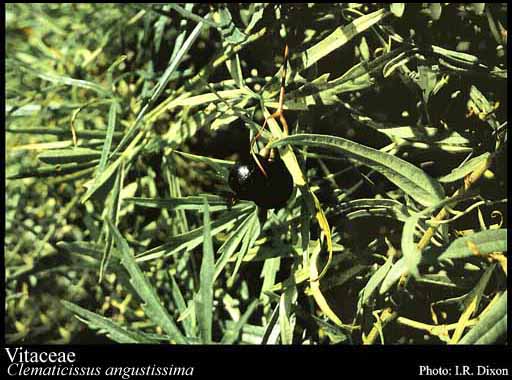- Reference
- Gen.Pl. [Jussieu] 267 (1789)
- Name Status
- Current

Scientific Description
Common name. Grape Family.
Habit and leaf form. Lianas (usually), or shrubs, or herbs (rarely); evergreen, or deciduous. Plants succulent (erect ‘treelets’), or non-succulent. Climbing (usually), or self supporting; the climbers tendril climbers, or tendril climbers and sucker climbers (usually with tendrils representing modified shoots or inflorescences, the tendrils often bearing suckers). Stem growth conspicuously sympodial (sometimes), or not conspicuously sympodial. Mesophytic, or xerophytic. Heterophyllous, or not heterophyllous. Leaves alternate, or opposite (the lower, sometimes); distichous (usually), or spiral; petiolate; non-sheathing; gland-dotted; simple (usually), or compound; when compound ternate, or pinnate, or palmate. Leaf blades when simple dissected (usually), or entire; commonly palmately lobed; palmately veined (commonly), or pinnately veined; cross-venulate. Leaves with stipules. Stipules intrapetiolar; caducous (often), or persistent. Leaves without a persistent basal meristem. Domatia recorded (4 genera); represented by pits, or pockets, or hair tufts. Stem anatomy. Nodes tri-lacunar, or penta-lacunar, or multilacunar (7). Secondary thickening developing from a conventional cambial ring, or anomalous; occasionally via concentric cambia (Tetrastigma).
Reproductive type, pollination. Fertile flowers hermaphrodite, or functionally male and functionally female, or functionally male, or functionally female, or hermaphrodite, functionally male, and functionally female. Unisexual flowers present, or absent. Plants hermaphrodite, or monoecious, or dioecious, or polygamomonoecious.
Inflorescence and flower features. Flowers aggregated in ‘inflorescences’; in cymes and in panicles. The terminal inflorescence unit cymose. Inflorescences leaf-opposed (usually), or terminal, or axillary (rarely); cymes or panicles, often complex. Flowers bracteolate; small; operculate (calyptrate) (e.g. in Vitis), or not operculate; regular; (3–)4–5(–7) merous; cyclic; tetracyclic. Free hypanthium present (short), or absent. Hypogynous disk present; intrastaminal; of separate members, or annular. Perianth with distinct calyx and corolla; (6–)8–10(–14); 2 -whorled; isomerous. Calyx (3–)4–5(–7); 1 -whorled; polysepalous (represented by lobes), or gamosepalous (reduced to a collar); entire, or lobed; if not entire, slightly lobulate, or blunt-lobed, or toothed; open in bud; regular; persistent. Corolla (3–)4–5(–7); 1 -whorled; gamopetalous; calyptrate (e.g. Vitis), or not calyptrate; valvate; regular. Fertile stamens present, or absent (female flowers). Androecium (3–)4–5(–7). Androecial members free of the perianth (inserted at the base of the disk); all equal; free of one another; 1 -whorled. Androecium exclusively of fertile stamens. Stamens (3–)4–5(–7); isomerous with the perianth; alternisepalous. Anthers dehiscing via longitudinal slits; introrse; tetrasporangiate (usually), or bisporangiate (sometimes). Fertile gynoecium present, or absent (male flowers). Gynoecium 2 carpelled (nearly always), or 3–6 carpelled. The pistil 2(–6) celled. Carpels reduced in number relative to the perianth (usually), or isomerous with the perianth. Gynoecium syncarpous; eu-syncarpous; superior. Ovary plurilocular; 2(–6) locular. Gynoecium stylate. Styles 1; apical. Stigmas 1; dry type; non-papillate; Group II type. Placentation axile. Ovules 2 per locule; ascending; apotropous; collateral; non-arillate; anatropous.
Fruit and seed features. Fruit fleshy; indehiscent; a berry; 4 seeded. Seeds endospermic. Endosperm ruminate (at least in Vitis); oily. Cotyledons 2. Embryo achlorophyllous (Vitis vinifera); straight. Seedling. Germination phanerocotylar.
Physiology, biochemistry. Aluminium accumulation not found. Photosynthetic pathway: C3 and CAM.
Geography, cytology, number of species. World distribution: cosmopolitan tropical to temperate. X = 11–20. 700 species.
Economic uses, etc. Important for the wine grape (Vitis vinifera) and other species supplying edible fruit for wine and raisins. Ornamental vines from Cissus, Parthenocissus.